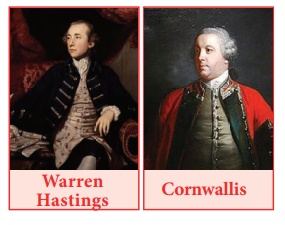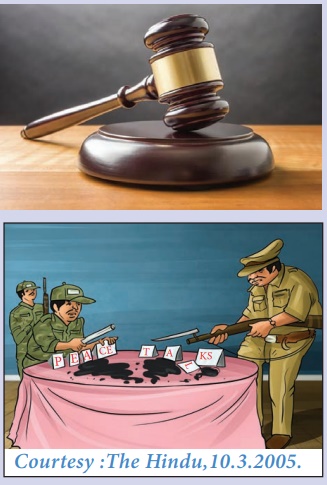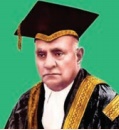Political Science - Judicial System in Modern India | 12th Political Science : Chapter 4 : Indian Judiciary
Chapter: 12th Political Science : Chapter 4 : Indian Judiciary
Judicial System in Modern India
Judicial System in Modern India
The East India Company was incorporated in 1601 by
the Charter of Queen Elizabeth I. The Charter granted recognition and authority
to the Company to facilitate the regulation of trade. With regard to the
administration in Madras, the Charter of 1661 led to the appointment of
Governor and the Council in each of its settlement. Once the company became a
territorial power, especially at Madras, it introduced an adhoc system of
judicial administration, in which the existing native systems were
accommodated, as the company preferred a policy of non-intervention in native
affairs. The Governor and the Council were empowered to decide on both civil
and criminal cases in accordance with the law of England. However, in disputes
involving only the natives the native traditions were continued. The year 1665
was of great significance as it witnessed the first trial by jury in Madras in
the case of Mrs. Ascentia Dawas during the Governorship of Fox Croft. The
appointment of Streynsham Master as the Governor in 1678 resulted in the
reorganization of the judicial system of Madras. The Court of the Governor and
Council came to be known as the High Court of Judicature and English was
declared as the court language. The Charter of 1683 led to the Company
establishing Courts of Admiralty to try traders committing various crimes on
high seas. The Charter of 1687 authorized the Company to create the Corporation
of Madras and the Mayor’s Court was attached to it. It functioned as a court of
record for the Madras town.
With regard to the administration of justice in
Bombay, the Charter of 1668 authorized the Company to exercise judicial
authority over Bombay. The proclamation of 1672 introduced English Law in
Bombay and the Court of Judicature and the new central court was established.
The application of English law was confined to cases involving Europeans and
European interests. The court exercised jurisdiction over civil, criminal and
testamentary cases. Further, Justices of Peace were appointed to administer
criminal law. After examining the witnesses and making an initial enquiry, the
cases were moved to the Court of Judicature. However, the invasion of Sidi
Yakub, the Mughal Admiral led to the dissolution of courts in Bombay in 1690.
After 12 years, in 1718, the Court of Judicature was revived. The court had
jurisdiction over civil and criminal matters. Though the court met only once a
week, it was highly regarded for its speedy trial and impartial decisions.
With regard to the Calcutta Presidency, the
Governor and the Council were endowed with judicial powers. In the case of
civil and criminal matters, the Company followed the already existing Mughal
system of judicial administration. The Faujdari Court presided over by the
English Collector decided on the criminal cases and the civil cases were
referred to an arbitrator by the Collector. The Collector played a very
important role in the judicial administration of Calcutta and the office dealt
with civil, criminal and revenue cases.
Thus, the Charter of 1687 applied only to Madras
while the Charter of 1726 constituted a Mayor’s Court in each of the three
Presidencies. The Charter of 1753 further reformed certain judicial provisions
of the Charter of 1726. It also set up five courts namely the Court of
Requests, the Mayor’s Court, the Courts of the President and the Council and
the King-in-Council. Another landmark in the evolution of Indian judiciary was
the Warren Hasting’s Plan of 1772. It regulated the system of judicial
administration. In 1780, he also reorganized the Provincial Adalats.
One of the major development in the field of
judiciary during the colonial period was the codification of native laws.

The first Governor General Warren Hastings caused
the codification at Hindu Law, and Cornwallis code was another major
contribution. Similarly, the Islamic law was also codified and adopted in
courts.
The Regulating Act of 1773 empowered the Crown to establish
the Supreme Court of Judicature in Calcutta and the Charter of 1774 expounded
on the jurisdiction of the court. However, the Supreme Courts were not
established at Bombay and Madras during the same period. The Supreme Courts
were established in Madras and Bombay in the years 1801 and 1824 respectively.
In 1793, Lord Cornwallis prepared “A Set of Regulations” popularly known as the
Cornwallis Code and it dealt with both civil and criminal justice. He
reorganized civil courts, abolished court fees and reformed criminal courts.
Lord Minto after being appointed as the Governor-General of Bengal in 1807
increased the powers and jurisdiction of the various courts. Lord Hastings who became
Governor General in 1813, introduced many reforms in the civil and criminal
judicature of the country. Efforts were taken to curb red -tapism in the
administration of justice. He was succeeded by Lord Bentinck who reorganized
and consolidated the whole system of judicial administration in India. He
abolished the Provincial Courts of Appeal and their functions were transferred to
District Diwani Adalats. Between 1834 and 1861, the King’s Court and the
Company’s Court formed the dual system of courts with separate jurisdictions.
The Indian High Courts Act of 1861 empowered the Crown to establish the High
Courts of Judicature at Calcutta, Madras and Bombay and this also led to the
abolition of Supreme Courts. This was considered a landmark in the evolution of
High Courts in India. Later, the Government of India Act of 1935 effected
considerable changes in the nature and jurisdiction of the High Courts. Between
independence and the enforcement of the Constitution, seven High Courts at
Punjab, Assam, Orissa, Rajasthan, Travancore, Mysore and Jammu and Kashmir were
established. The other High Courts were established later. The Constitution of
India after being enforced recognized all the existing High Courts and
empowered the Parliament to establish High Courts for all the States or
combined High Courts for two or more States and Union Territories. The 42nd
Constitutional Amendment Act, 1976 brought in drastic changes in the
jurisdiction of the High Courts.

Thus, in the very beginning, there were only the
three High Courts of Calcutta, Madras and Bombay. The Acts and regulations
prior to independence brought in remarkable changes in their organization and
jurisdiction, thereby ensuring their independence and impartiality. After the
enforcement of the Constitution, their positions have been strengthened and
apart from their original and appellate jurisdiction in civil and criminal
cases they also act as the protector and interpreter of the Constitution.
Source: Sumeet Malik, V.D. Kulshreshtha’s Landmarks in Indian
Legal and Constitutional History, EBC Publishing Private Ltd, Lucknow, 2017.
With respect to the establishment of the Supreme
Court of India, the Government of India Act, 1935 is a landmark legislation.
The Act attempted to change the structure of the Indian government. There was a
shift from a ‘unitary’ to a ‘federal’ type of government necessitating the need
of a Federal Court. Thus, the Act made specific provision in this regard and
the Federal Court was inaugurated in the year 1937. It consisted of a Chief
Justice and six judges. In 1950, the Federal Court of India was succeeded by
the Supreme Court of India. The Federal Court in its short span of 12 years
left an indelible impact on the legal history of India. It was the first court
with a national jurisdiction. It was from this Federal Court that its successor
inherited the traditions of independence, integrity and impartiality. Also,
between 1726 and 1833, the role of the Privy Council requires special mention.
It contributed immensely to the judicial system of India, laying down the
fundamental principles of Indian law that serve as a beacon to the Indian
Courts even today.
The Indian Independence Act, 1947 resulted in the
transfer of political power and this necessitated the establishment of a
separate and independent judicial body. With this objective, the jurisdiction
of the Federal Court was enlarged and the Abolition of the Privy Council
Jurisdiction Act, 1949 was passed making the Federal Court of India the highest
judicial body in the country. With the enforcement of the Constitution on 26
January 1950, Article 124 provided for the establishment of the Supreme Court
of India. Thus, there has been a slow and steady evolution of the Indian
judicial system and it has proven to be better and wiser with time.
Activity
Read more about the
case of
Mrs. Ascentia
Dawas, the first trial by jury in Madras.
Activity
A Landmark Verdict
In a blow to both the Chhattisgarh government
and the Centre, the Supreme Court has declared as illegal and unconstitutional
the deployment of tribal youths as Special Police Officers - either as ‘Koya
Commandos’, SalwaJudum or any other force - in the fight against the Maoist
insurgency and ordered their immediate disarming. The ruling - issued by
Justice B. Sudershan Reddy and Justice S.S. Nijjar on the writ petition filed
by social anthropologist Prof. Nandini Sundar and others - strongly indicted
the State for violating Constitutional principles in arming youth who had
passed only fifth standard and conferring on them the powers of police.

Writing the order,
Justice Reddy directed the State of Chhattisgarh to immediately cease and
desist from using SPOs in any manner or form in any activities, directly or
indirectly, aimed at controlling, countering, mitigating or otherwise
eliminating Maoist/Naxalite activities in the State of Chhattisgarh. The Bench
made it clear that the State of Chhattisgarh should take all appropriate
measures to prevent the operation of any group, including but not limited to SalwaJudum
and Koya commandos, that in any manner or form seek to take law into private
hands, act unconstitutionally or otherwise violate the human rights of any
person. The Bench said “The primordial value is that it is the responsibility
of every organ of the State to function within the four corners of
constitutional responsibility. That is the ultimate rule of law.”
Courtesy : The Hindu, 3.8.2011.
Group Discussion
Teacher can organise a Group Discussion about the landmark judgement of the Supreme Court of India. Time allotted : 20 minutes
Activity
Read more about the
Privy Council and have a discussion in class about its significance in the
evolution of judicial administration in India.
Sir Hari Singh Gour
In 1921, Sir Hari Singh Gour was the
first person in the legal history of India to realize the necessity of
establishing an All-India Court of Final Appeal in place of the Privy Council.

Related Topics